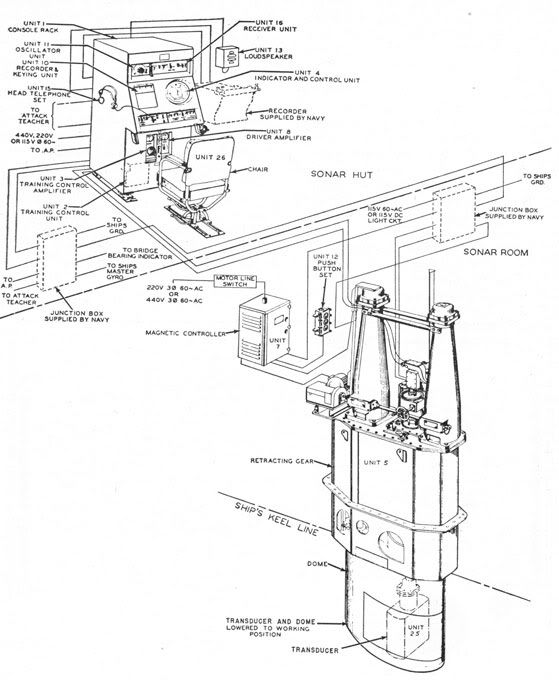Rick,
I still am leaning towards a retractable Sonar Dome on the early Fletchers. I'm still researching it but at first blush this picture of the equipment i believe is on the ship, shows a retractable unit.

Now for my purposes of building a model..............this doesn't amount to a hill of beans. My dome will be down. I thought that was the purpose of the sea chest to provide an opening to raise and lower. Other wise it would just need a small opening for the cabling.
From the HNSA website:
"The transducer itself is mounted in a sea chest and the transducer and its hoisting units are raised and lowered inside this chest. When in the raised position, the sound dome seals off the sea chest so that water cannot enter the ship if the top of the chest were removed. Sealing off the chest in this manner permits installation, removal and servicing of the transducer and its training mechanism while the ship is at sea or in port. All other units of the system are accessible from the interior of the ship."
From the USS Slater website which used a slightly smaller version of the QJB sonar system:
Quote
DOME
the retracted position, the dome protruded three inches below the keel and was 45 inches (3 ¾ feet) below the keel when extended. A two horsepower motor was required to raise and lower the dome with a provision to do it manually. A set of indicator lamps in the Sonar office indicated the position of the dome -- red was for the working position, green was for housed and red/green for any intermediate state. In the housed position, the dome, the raft, and the oscillator were drawn up to the top of the trunk. The top of the raft butted up against a seating ring under the top of the trunk, thus making a watertight joint. This allowed the portable cover to be unbolted, in the event that either of the oscillators had to be changed. The procedure would only work if the dome was undamaged.
The Staybrite window of the dome, was aligned with the face of the oscillator so sound waves could be transmitted and received in a 360 degree arc in 5 degree steps. Staybrite was secured over a ribbed section of heavy cast metal and this ribbing is what produced the window effect.
Maximum design speed for the dome was 25 knots. When retracting or extending the dome, it was necessary to check the voltage of the mains supply. In a 220 volt mains' system, the voltage could not drop below 180 volts. If it did, the contactor in the control board could fail to operate thus causing the dome to bump against the end stops and cause damage.
The dome was normally housed for any of the following conditions: when working cables; when working bottom lines; when entering or leaving harbor; when steaming into a heavy sea; if cessation of Sonar operations could be tolerated; and finally, when navigating in shoal water and Sonar is not required for navigation.
Unquote
I'm just curious. Building this kit has got me "looking"...............
Regards
Steve



